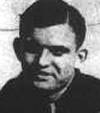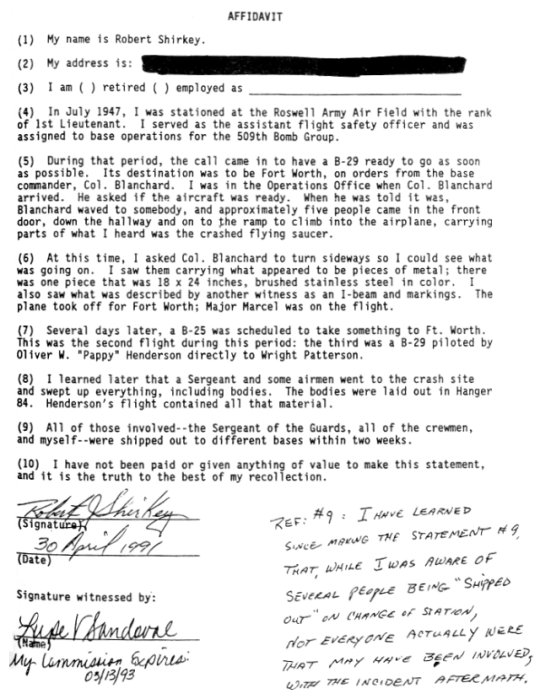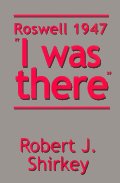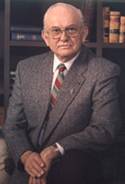Robert Shirkey(Robert SHIRKEY, Robert J. SHIRKEY). |

|
Please, before asking any question or sending any comment or criticism, read this.
Under construction.

|
|
AFFIDAVIT (1) My name is Robert Shirkey (2) My address is: [Retained for respect of privacy] (3) I am ( ) retired ( ) employed as: (4) In July 1947, I was stationed at the Roswell Army Air field with the rank of 1st Lieutenant. I served as the assistant flight safety officer and was assigned to base operations for the 509th Bomb Group. (5) During that period, the call came in to have a B-29 ready to go as soon as possible. Its destination was to be Fort Worth, on orders from the base commander, Col. Blanchard. I was in the Operations Office when Col. Blanchard arrived. He asked if the aircraft was ready. When he was told it was, Blanchard waved to somebody, and approximately five people came in the front door, down the hallway and on to the ramp to climb into the airplane, carrying parts of what I heard was the crashed flying saucer. (6) At this time, I asked Col. Blanchard to turn sideways so I could see what was going on. I saw them carrying what appeared to be pieces of metal; there was one piece that was 18 x 24 inches, brushed stainless steel in color. I also saw what was described by another witness as an I-beam and markings. (7) Several days later, a B-25 was scheduled to take something to Ft. Worth. This was the second flight during this period: the third was a B-29 piloted by Oliver W. "Pappy" Henderson directly to Wright-Patterson. (8) I learned later that a Sergeant and some airmen went to the crash site and swept up everything, including bodies. The bodies were laid out in Hangar 84. Henderson's flight contained all that material. (9) All of those involved -- the Sergeant of the Guards, all of the crewmen, and myself -- were shipped out to different bases within two weeks. (10) I have not been paid or given anything of value to make this statement, and it is the truth to the best of my recollection. Signed: Robert Shirkey Signature witnessed by: |
Note later added by Robert Shirkey to the above affidavit:
|
I have learned since making the statement (9) that, while I was aware of several people being "shipped out" on change of station, not everyone actually were that may have been involved with the incident aftermath. |
Under construction.
|
Roswell Witnesses Interviewed Robert Shirkey Interview:509th Bomb Group operations officer Robert Shirkey first learned that something unusual was being flown to Fort Worth when he returned from lunch July 8, 1947 and wonders if his interest in it caused him to be transferred unexpectedly to a non-existent job days later.
Shirkey said the debris that he saw loaded aboard the bomber looked nothing like weather balloons he saw launched from the weather building located near his own office at Roswell Army Airfield. Shortly after this event, Shirkey, who was awaiting promotion to captain and assignment to a new job at Roswell air base, shortly afterward received some startling news.
His orders, oddly enough, were signed by Brig. Gen. Roger Ramey, the Eighth Air Force commander who ordered Marcel to pose next to the debris that Marcel said was not what he had recovered. If Shirkey felt he was being shuffled away from Roswell unceremoniously he found himself receiving unusually grand treatment in the way he was to fly to Hamilton Field, Calif., on the way to the Far East. Deputy Base Commander Lt. Col. Payne Jennings, who flew the B-29 with the debris aboard to Fort Worth, informed Shirkey that he would personally fly him to California for his next assignment.
When he arrived at Clark Field in the Philippines he had another surprise when he was informed that no such job vacancy existed. Shirkey was told the 13th Air Force had a weights and balance officer and didn't need one. He would instead be made assistant operations officer in a photo reconnaissance unit. As far as Shirkey's concerned, his inexplicable departure from Roswell "was part of the cover-up" of the saucer crash. Today, Shirkey teaches oil field safety techniques at a junior college branch of Eastern New Mexico University located on the grounds of the former Roswell Army Airfield. Nearby is the one-time operations center, where Shirkey worked. It is today used by an aviation firm. |
ABQ journal published the following:
|
One of the six New Mexicans directly affected by the crash of what was first called a UFO, then a weather balloon, shares memories of the event 50 years ago Robert Shirkey, 74
First Lt. Shirkey was the assistant operations officer of the 509th Bomb Group in July.
The plane lifted off about 2 p.m., and at 3 p.m. the Roswell Daily Record hit the streets with the story of the flying saucer. Shirkey teaches oilfield safety classes at the Roswell branch of Eastern New Mexico University, which has its campus across the street from the old air field. |
Source for the above paragraphs:
"A call came in to have a B-29 ready to go as soon as possible. Where to? Forth Worth, on Colonel Blanchard's directive. [I was] in the Operations Office when Colonel Blanchard arrived and asked if the airplane was ready. When told it was, Blanchard waved to somebody, and approximately five people came in the front door, down the hallway, and onto the ramp to climb into the airplane, carrying parts of the crashed flying saucer. I got a very short glimpse, asked Blanchard to turn sideways so [I] could see too. Saw them carrying pieces of metal. They had one piece that was eighteen by twenty-four inches, brushed stainless steel in color."
Source:
|
Robert Shirkey wrote a book:
Note: the book is listed on amazon.com but is currently (September 2003) not available anymore. |

|
A brief review of the book "I was there" by Robert Shirkey:
The book is a 154 pages paperback with large typeface and almost double interlining. This may appear to be quite a short narration, said critics, but on the other end, it is more than the usual affidavit or interviews.
A preface to the book by the now self-discredited witness Frank Kaufmann is much more worrying and suggests that, as an investigator, Shirkey may have bought Kaufmann's tall tales.
Although it seems acceptable and factual that Robert Shirkey did stand at the Operations Desk of the Roswell Air Field with Colonel Blanchard while men were loading cardboard boxes of aluminum-looking metal pieces onto a B-29 aircraft, the book does not add much to the essence of his testimony as can be read in his affidavit and interviews. The main interest of the book is that it does confirm several aspects of the case, such as the several flights for the debris. Other aspects reported by Shirkey, such as the bodies and Hangar 84 were only told to him and he reports what he has been told by other.
Some critics have made the confusion there: on one side, there is Robert Shirkey the witness, telling what he allegedly witnessed. On the other side, Robert Shirkey started is own investigation, interviewing other witnesses, and thus told what other claimed to have seen. Once the distinction is understood, there is little sense left in the criticism that he did not see in person what other people reported to him, as an investigator.

Robert Shirkey, 2001.
The events directly witnessed by Robert Shirkey as narrated in his book are, in short, that on July 8, 1947, he went to duty to the Operations Building at Roswell army Air Field, and is met by his colleague Earle Williams. Williams tells him that Colonel Blanchard has ordered a B-29 to be readied for a flight to Carswell AFB, Fort Worth, Texas, at 02:00 P.M. When the plane is ready, Shirkey and Blanchard are watching several men loading cardboard boxes filled with aluminium looking debris into the plane. Then arrives Major Jesse A. Marcel with a box filled with little pieces of metal, different from the pieces loaded by the other men. Among these pieces he saw an I beam with markings but he could not observe the markings and determine what they were. Then a civilian boards the plane, holding a large metal piece under the arm. The large metal piece had torn egdes but its surface is flat without any traces of damages. Other debris are loaded directly from a jeep. The planes takes off as scheduled at 02:00 P.M. Later that day, he heard that there was a flying saucer that had been recovered, and he understood that what he has seen loaded to the B-29 was related debris.
Source:
The above is the source.
A brief review of the book "I was there" by Robert Shirkey:
|
Next we have "I Was There", which is another in the endless series of pro-Roswell books, this one written by a former Air Force Captain named Robert Shirkey. Frank Kaufmann, a well-known alleged Roswell witness, is a major contributor to this book, though his name is not on the cover. Amusingly, Shirkey decided not to use any material from famed Roswell witness Glenn Dennis. Dennis gave Shirkey the brush-off when asked to contribute, so Shirkey thereafter concluded that Dennis' story of Nurse Naomi Marie Selff (?) was not provable, and therefore not worth using in the book anyway. Shirkey's claim to fame is that, at the time of the Roswell Incident, he was Assistant Group Operations Officer for the 509th Bomb Group at Roswell Army Air Field. He allegedly watched the crash site debris being carried through the Operations Building & loaded onto a waiting B-29. |
Source:
The unrecoverable telex:
Robert Shirkey has said how he has been oddly reassigned to another location after the incident. Under FOIA, Roswell investigator Dennis G. Balthaser proposed Shirkey to request a copy of the military teletype dated on or about 17 July, 1947, from 8th Air Force, Fort Worth, Texas, reassigning Lt. Robert Shirkey from Roswell Army Air Field to Clark Field, Philippines. He requested the copy by letter on March 17, 1999.
The Military Personnel Records center in St Louis, Missouri, finally answered to Balthaser on August 22, 2000 that this record has been among those lost in the fire that occurred there on July 12, 1973.
Balthaser commented in a letter to Robert Shirkey that "I really find it rather odd that many of the records needed on personnel assigned to Roswell in 1947 were amongst those lost in that fire."
Source:
The above is the source.